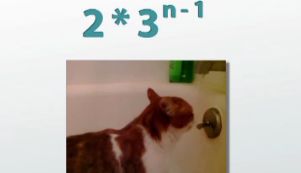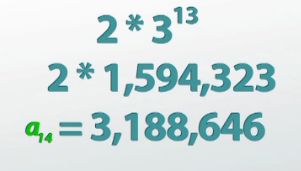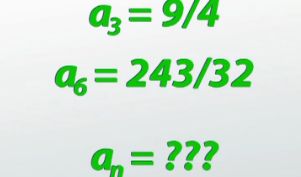Finding and Classifying Geometric Sequences
After you watch the video and know the material, click HERE for the quiz.
Want your YouTube video to get a lot of hits? Besides including a cute baby or an adorable cat, getting your video to have a big common ratio is the key. Learn what I'm talking about here!
Geometric Sequences of Views of Cat Videos
A sequence is just a pattern, and a geometric sequence is a pattern that is generated through repeated multiplication. Each new term is made by multiplying the previous one by the same thing over and over. For example, we could have the finite geometric sequence 5, 10, 20, 40, 80 by starting with 5 and multiplying by 2 four times. Or we could get the infinite geometric sequence 8, 4, 2, 1, ½, ¼, … by beginning with 8 and repeatedly multiplying by ½, which ends up looking very similar to division.
As it turns out, we see these patterns all over the place. I've watched a lot of YouTube videos, and I've decided that my best bet to getting a really popular video is to get a cat and just follow it around with a camera 24/7. It would be bound to do something cute eventually, especially if I put a goofy hat on it or something.
 |
Within the first day of getting one of these funny videos I'd probably send it to my girlfriend, and then we'd both post it to our Facebook walls. At the end of the day, we'd be the only two people that had seen it. But let's say that within the next day, 3 of my friends and 3 of her friends had watched it, making 6 new hits. Then if each of those people were able to get 3 more people, that would be 18 more views, and then if each of those people got 3 of their friends we're already up to 54 more views in 4 days (a4=54)! 5 days in and I get 162 new hits (a5=162), 6 days brings in 486 (a6=486)… now we're getting somewhere!
It's important to note that the sequence we're making right now is only the number of new views I'm getting each day. Figuring out how many total views we'll reach is something we're going to save for a later lesson. What we can find now is how many new views I'd get in any specific day. Simply using the pattern can help us figure out how many hits I'd be getting in the first few days, but trying to use the pattern one entry at a time to figure out how many new hits I'd get after a couple weeks would not only be long and tedious, I'd also probably end up making a mistake somewhere along the way.
Creating a Formula of a Geometric Sequence
What I'd rather have is a formula that will tell me how many new hits I get at any time simply by substituting in a number. Looking back at the entries we came up with so far will help us to see the pattern that we can try to generalize into a formula. We started at a1=2, then went up to a2=6 (2x3), then a3=18 (2x3x3), then 54 happened because we multiplied by 3 again (2x3x3x3). I keep on multiplying by 3, so the next one is 2x3x3x3x3. We can start condensing these multiplications by 3 into exponents, which means the sixth term would be 2x3^5. Notice that the sixth term had an exponent of 5 on the 3. If I condense the 3s into exponents on the fifth term, I get the 4th power; if I condense them on the fourth term, I get the 3rd power; the third term's the 2nd; the second term's the 1st; and the first term we can call the 0 power, because anything to the 0 power is 1, so we just get 2 x 1, or 2.
Generalizing the pattern for any term, this means that for any day n after I posted the video, the number of new hits is 2x3^n-1. The 2 in front represents the beginning value a1, the 3 represents what would be called the 'common ratio' and the n-1 represents how many times we had to multiply by 3. It's n-1 because we didn't get any new hits until the second day.
 |
Now to figure out how many new hits I'm going to get after two weeks is pretty straightforward. I want to know how many new hits I'm going to get on the 14th day, so we substitute 14 in for n. That gives us that a14=2x3^(14-1) power. We do 3^13 power and we get 1,594,323. We multiply that by 2 and it turns out that 14 short days after I posted the video I'm getting 3,188,646 new hits! My cat has officially gone viral! Soon there will be a meme based on his picture.
 |
What we just came up with is the general rule for the nth term of a geometric sequence, an=a1r^n-1. This is actually pretty similar to an exponential function, only the letters have been changed around. An is the general nth term, a1 is the first term, r is the common ratio, or the amount that we multiply by every step of the way. It's called the common ratio because if you divide any two consecutive terms you'll get the same thing. Lastly, the n in the n-1 power is whatever term you're trying to find out. Apparently, if you can come up with a YouTube video that has a common ratio of 3, you're on your way to internet stardom!
Finding a Geometric Sequence Using Terms
We can also come up with the rule to a geometric sequence by simply being given any two entries. Say we know that a3=9/4 and a6=243/32. We want to know what the rule is for the nth term. I like drawing this out visually so we know what's going on. I don't know what the first term or the second term is, but I do know that the third term is 9/4. The fourth term and the fifth term are unknown to me, but the sixth term is 243/32. Because it is a geometric sequence, I know that when I started with my third term (9/4) I simply multiplied by r three times in a row to get my sixth term, which means that 9/4r^3 = 243/32.
 |
Now what I've set up is an equation that I can solve using inverse operations to figure out what the common ratio r must be. I undo multiplication by a fraction by multiplying by its reciprocal, 4/9, which gives me 27/8 on the right hand side. I can then undo a third power with a third root. I take the cubed root of both sides and find that the cubed root of 27 is 3 and the cubed root of 8 is 2, and I find that our common ratio is 3/2. The only other thing needed for our rule besides r is a1, which does mean that I have to work my way backwards to find a1. I can come back to my picture and divide by r. I divide once by 3/2 and get 3/2, and I divide one more time by 3/2 and find that a1 is simply equal to 1. This means that my rule an=a1r^n-1 is an = 1 x 3/2^n-1. Because multiplying by 1 doesn't actually change anything, I can just condense my rule to an=3/2^n-1.
Summary
A geometric sequence is a pattern of numbers generated by repeated multiplication, similar to exponential functions. Because it's similar to an exponential function, the general rule for a geometric sequence has an exponent in it, and we get an=a1r^n-1 as the rule for the nth term of a geometric sequence. This general rule can help us find terms of a geometric sequence that are far away from the beginning.